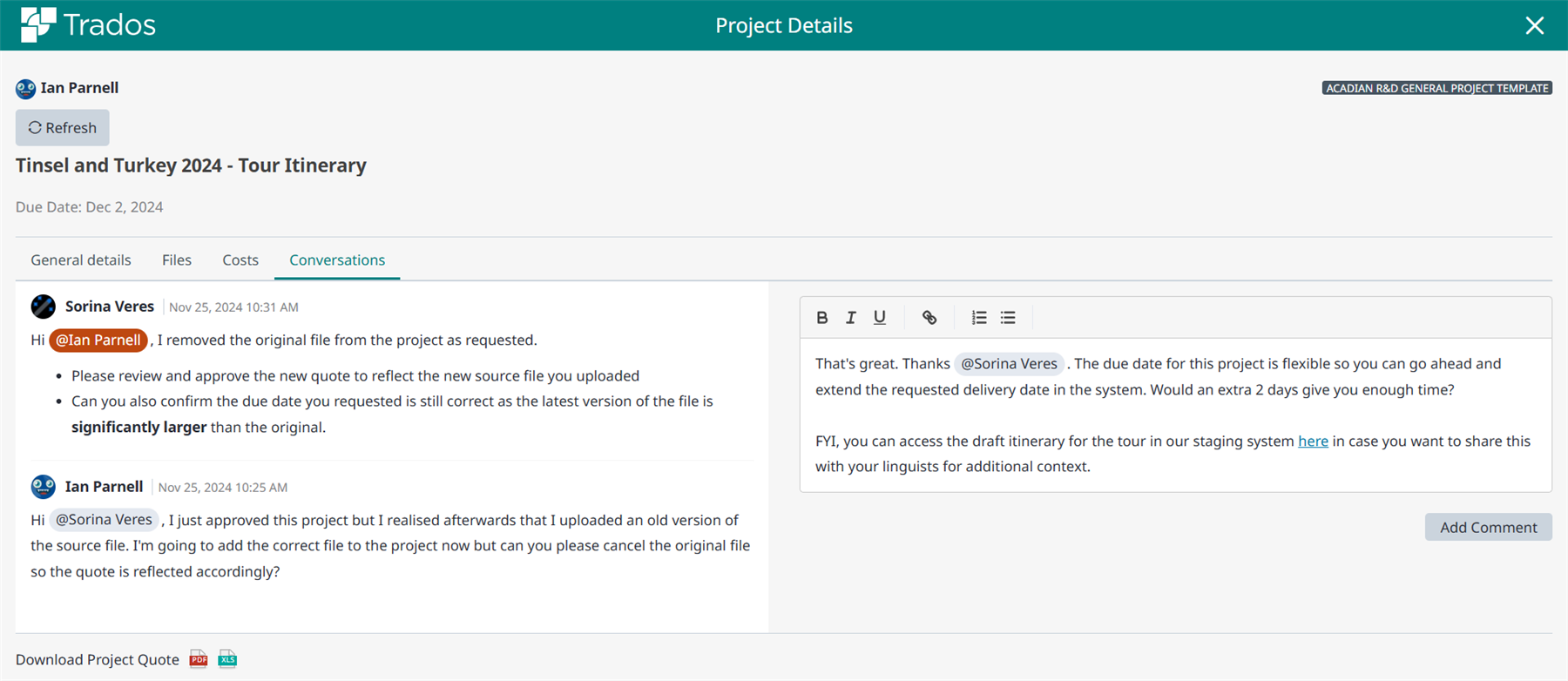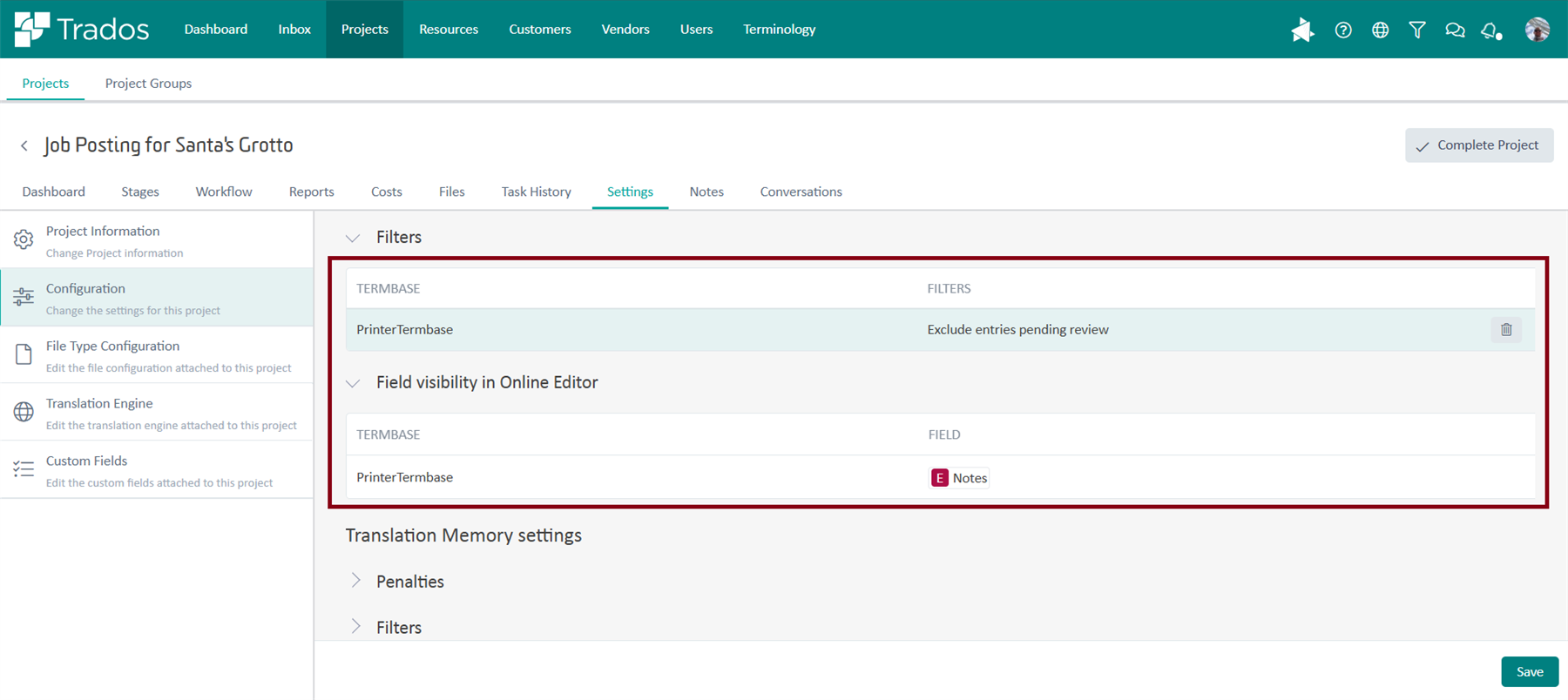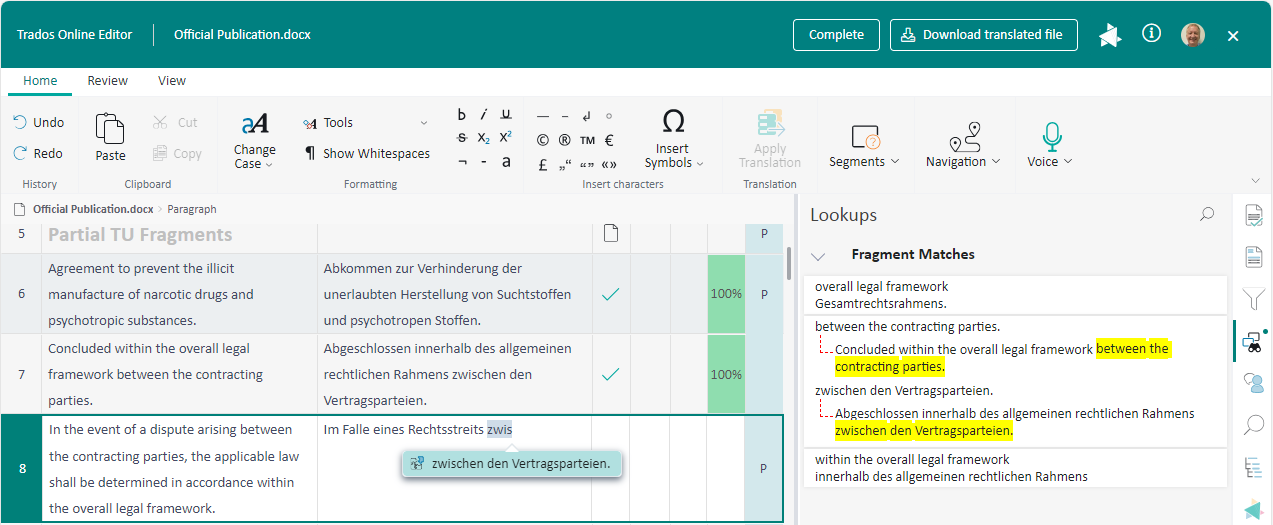We have just released the latest update to Trados Enterprise translation management capabilities, and we would like to share the new functionality that has been delivered.
New features and updates are automatically added to your account so just login to Trados Enterprise and they will be available immediately.
Project conversations and terminology comments now support user mentions and rich text
We have enhanced the functionality of Project Conversations and Terminology comments, by introducing support for user mentions, so you can @-tag a user to notify that person specifically.
Additionally, we have added support for rich text formatting, allowing users to include bold text, hyperlinks, bulleted or numbered lists, and more.

More control over Terminology in Online Editor
We have now added multiple options in Project Settings and Translation Engines when working with Online Editor.
You can now specify which Termbases should be used for lookup in a Translation Engine.
In Project Settings you can now define which fields are to be shown in termbase lookups from the Online Editor. In addition, it will be possible to define filters in Project Settings which will subsequently be applied for terminology verification and when performing terminology lookups in the Online Editor.
Note: Termbase filtering will be deployed separately from the main release but we expect this to be available in the next few days.

Workflow Phases view
We have introduced several improvements to the Workflow > Phases view, based on user feedback.
Additional operations can now be performed from the More Actions menu, including the ability to copy/paste assignment and configuration settings.

We have introduced an option to show/hide the expanded details view for task tiles.

Users can now right-click in a task tile to reveal the actions available at both task and language level.
Dynamic fragment recall powered by modern AI-based neural word and phrase alignment
We have introduced next-generation fragment recall, based on cutting-edge AI-based neural word and phrase alignment working its magic behind the scenes. This is an exciting innovation that can provide significantly higher quality results when using the fragment recall capability, resulting in potential productivity gains for linguists.
The new neural fragment recall capability is currently available for the following language pairs and applies to all combinations of the regional-specific languages (English – United States, English – United Kingdom, etc.)
- English <> French
- English <> German
- English <> Spanish
Unlike the previous traditional TM-based fragment alignment (also referred to as upLIFT), the new fragment results are available without any preconditions. The fragments are recalled seamlessly in the interactive translation flow, and it is no longer necessary for cloud-based translation memories to contain a specific number of translation units to benefit from this functionality – in fact, translation memories are no longer needed.
In addition to the interactive translation flow, the same functionality is also available for linguists working with cloud-based translation memories in Trados Studio.

In the above example, I have a TM with just two segments that I translated so far - segments 6 and 7. Previously, fragment recall would not deliver any suggestions as the TM does not contain enough translation units. With the latest innovations, however, I only require a single translation unit before I can start to benefit from fragment recall functionality.
In the above screenshot, I am translating segment 8, which has some fragment matches which occurred in segments 6 and 7.
- between the contracting parties
- overall legal framework
- within the overall legal framework
In segment 8, those fragments are dispersed and there is no match coming from the translation memory – still, these fresh fragments come up magically thanks to the neural phrase alignment that was performed in the meantime. In the example, I am typing "zwis" which suggests the fragment "zwischen den Vertragsparteien" which I can then take over as is.
We believe this is an AI-powered breakthrough powering linguist productivity going far beyond what was possible so far.
Connector Updates
Trados Translation Connector for Figma version 1.5.0 is now available in the Figma marketplace here.
Public API: UI Extensibility BETA
As announced recently, we have introduced support for User Interface (UI) Extensions which offer the possibility to add custom user interface elements and functionality. Custom buttons and panels can be added to specific places within the user interface.
UI Extensibility is initially being offered in BETA. Customers interested in evaluating this functionality should keep in mind that significant changes are planned prior to the full release. For more details, please refer to the documentation page.
API Updates
- We have transitioned the hosting of our API from lc-api.sdl.com to api.eu.cloud.trados.com on November 9th:
- lc-api.sdl.com for API and integrations will remain active.
- Existing integrations will continue to work as before but we recommend customers change to the new URL when possible.
- For new integrations, we recommend using the new URL to avoid additional work in the future.
- You can now add notes to customer quotes.
- We have updated the deprecated types for the language and targetLanguages fields in the Add Source File Request model, which now reference Language Request model. In the updated API contract, these fields have been changed from simple strings to structured objects containing a languageCode property, enhancing clarity and consistency in language handling.
We will provide backwards compatibility until May 2025. However, starting with this release, SDKs will be updated to use the new types. Please ensure your integration is updated to use the new Language Request model.
Additional changes
- When importing to a termbase, you can now select field(s) from the termbase definition to map values to one of the Status (System) values in Trados
- Users can now choose whether to include translation memories and termbases when downloading a package
- If an MT model is unavailable during the Machine Translation task, you can now specify in the workflow task configuration if an error task is created or if the default behaviour is applied and the task is skipped.
- We have introduced a usability improvement which allows users to select and clear all entries in various table views in the Trados interface
- For service users, we have introduced a new option that allows you to configure additional users to receive notifications. Note: this feature will be deployed separately from the main release but we expect this to be available in the next few days.
- Various bug fixes and UX enhancements
We hope this post was informative and we look forward to continuing to provide you with updates to the product.
Trados Product Management

 Translate
Translate

